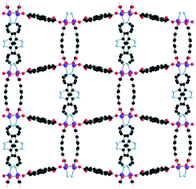当前位置:
X-MOL 学术
›
CrystEngComm
›
论文详情
Our official English website, www.x-mol.net, welcomes your
feedback! (Note: you will need to create a separate account there.)
The impact of N,N′-ditopic ligand length and geometry on the structures of zinc-based mixed-linker metal–organic frameworks
CrystEngComm ( IF 2.6 ) Pub Date : 2017-09-18 00:00:00 , DOI: 10.1039/c7ce01447c Andrew D. Burrows 1, 2, 3, 4 , Siobhan Chan 1, 2, 3, 4 , William J. Gee 1, 2, 3, 4, 5 , Mary F. Mahon 1, 2, 3, 4 , Christopher Richardson 6, 7, 8, 9 , Viorica M. Sebestyen 1, 2, 3, 4 , Domenyk Turski 1, 2, 3, 4 , Mark R. Warren 4, 10, 11, 12
CrystEngComm ( IF 2.6 ) Pub Date : 2017-09-18 00:00:00 , DOI: 10.1039/c7ce01447c Andrew D. Burrows 1, 2, 3, 4 , Siobhan Chan 1, 2, 3, 4 , William J. Gee 1, 2, 3, 4, 5 , Mary F. Mahon 1, 2, 3, 4 , Christopher Richardson 6, 7, 8, 9 , Viorica M. Sebestyen 1, 2, 3, 4 , Domenyk Turski 1, 2, 3, 4 , Mark R. Warren 4, 10, 11, 12
Affiliation

|
Combining Zn(NO3)2·6H2O with a series of dicarboxylic acids in the presence of the N,N′-ditopic ligand di(4-pyridyl)-1H-pyrazole (Hdpp) results in a series of mixed-linker metal–organic frameworks (MOFs) that have been crystallographically characterised. The reaction with 1,4-benzenedicarboxylic acid (H2bdc) gives [Zn2(bdc)2(Hdpp)2]·2DMF 1, which shows Zn2(μ-carboxylate)2(carboxylate)2 secondary building units (SBUs) linked by bdc ligands into sheets, and these are pillared by the Hdpp linkers into a doubly-interpenetrated three-dimensional network. The reaction with 1,4-naphthalene dicarboxylic acid (H2ndc-1,4) gives two products: [Zn2(1,4-ndc)2(Hdpp)]·4DMF 2a forms a three-dimensional network in which sheets, formed from Zn2(carboxylate)4 ‘paddle-wheel’ SBUs being linked by 1,4-ndc, are connected together by Hdpp pillars, whereas [Zn(1,4-ndc)(Hdpp)]·DMF 2b forms a fourfold interpenetrated structure based on diamondoid networks with single zinc centres as nodes. The reaction with 1,3-benzenedicarboxylic acid (H2mbdc) produces [Zn(mbdc)(Hdpp)]·DMF 3, which forms a two-dimensional network with (4,4) topology in which ZnO2N2 nodes are interlinked by mbdc and Hdpp linkers. The reaction with 5-methyl-1,3-benzenedicarboxylic acid (H2mbdc-Me) also forms a two-dimensional network structure, [Zn2(mbdc-Me)2(Hdpp)2]·DMF 4, albeit wherein dicarboxylates bridge between zinc-dicarboxylate tapes, themselves formed by interlinking of Zn2(μ-carboxylate)2(carboxylate)2 SBUs similar to those in 1. Finally, the reaction with 2,6-naphthalene dicarboxylic acid (H2ndc-2,6) yields two crystalline species, both having the formula [Zn2(2,6-ndc)2(Hdpp)]·DMF 5a/5b and possessing infinite zinc-carboxylate chain motifs interlinked by both naphthalene rings and Hdpp linkers into a three-dimensional framework. In compounds 1, 2b, 3 and 4, the pyrazole NH groups are involved in hydrogen bonding that serves to link either interpenetrated networks or neighbouring sheets together. However, in 2a and 5a/5b the NH groups project into the pores of the framework enabling interactions with guest molecules.
中文翻译:

的影响Ñ,Ñ '-ditopic配体的长度和几何形状上的锌基混合接头金属有机骨架的结构
在N,N'-二位配体二(4-吡啶基)-1 H-吡唑(Hdpp)存在下,将Zn(NO 3)2 ·6H 2 O与一系列二元羧酸结合会产生一系列混合的晶体学表征的连接子金属有机骨架(MOF)。与1,4-苯二羧酸(H反应2 BDC)给出[锌2(BDC)2(HDPP)2 ]·2DMF 1,其示出的Zn 2(μ-羧酸酯)2(羧酸酯)2由bdc配体连接成片的二级建筑单元(SBU),由Hdpp接头将其构建成双互穿的三维网络。与1,4-萘二甲酸(H 2 ndc-1,4)的反应产生两种产物:[Zn 2(1,4-ndc)2(Hdpp)]·4DMF 2a形成三维网络,其中薄片由Zn 2(羧酸盐)4 '桨式'SBU通过1,4-ndc连接而形成的环,通过Hdpp柱连接在一起,而[Zn(1,4-ndc)(Hdpp)]·DMF 2b形成基于以单个锌中心为节点的类金刚石网络的四重互穿结构。与1,3-苯二甲酸(H 2mbdc)产生[Zn(mbdc)(Hdpp)]·DMF 3,它形成具有(4,4)拓扑的二维网络,其中ZnO 2 N 2节点通过mbdc和Hdpp接头互连。与5-甲基-1,3-苯二甲酸(H 2 mbdc-Me)的反应也形成了二维网络结构,[Zn 2(mbdc-Me)2(Hdpp)2 ]·DMF 4,尽管其中二羧酸盐二羧酸锌带之间的桥,它们本身是由Zn 2(μ-羧酸盐)2(羧酸盐)2 SBU相互连接形成的,类似于图1中的那些。最后,与2,6-萘二甲酸(H 2 ndc-2,6)的反应产生两种晶体,均具有分子式[Zn 2(2,6-ndc)2(Hdpp)]·DMF 5a / 5b并具有通过萘环和Hdpp接头相互连接成三维框架的无限羧酸锌链基序。在化合物1,图2b,3和4,吡唑NH团参与,其用于任一互穿网络或相邻片材连接在一起的氢键。但是,在2a和5a / 5b中 NH基团伸入框架的孔中,从而可与客体分子相互作用。
更新日期:2017-09-18
中文翻译:

的影响Ñ,Ñ '-ditopic配体的长度和几何形状上的锌基混合接头金属有机骨架的结构
在N,N'-二位配体二(4-吡啶基)-1 H-吡唑(Hdpp)存在下,将Zn(NO 3)2 ·6H 2 O与一系列二元羧酸结合会产生一系列混合的晶体学表征的连接子金属有机骨架(MOF)。与1,4-苯二羧酸(H反应2 BDC)给出[锌2(BDC)2(HDPP)2 ]·2DMF 1,其示出的Zn 2(μ-羧酸酯)2(羧酸酯)2由bdc配体连接成片的二级建筑单元(SBU),由Hdpp接头将其构建成双互穿的三维网络。与1,4-萘二甲酸(H 2 ndc-1,4)的反应产生两种产物:[Zn 2(1,4-ndc)2(Hdpp)]·4DMF 2a形成三维网络,其中薄片由Zn 2(羧酸盐)4 '桨式'SBU通过1,4-ndc连接而形成的环,通过Hdpp柱连接在一起,而[Zn(1,4-ndc)(Hdpp)]·DMF 2b形成基于以单个锌中心为节点的类金刚石网络的四重互穿结构。与1,3-苯二甲酸(H 2mbdc)产生[Zn(mbdc)(Hdpp)]·DMF 3,它形成具有(4,4)拓扑的二维网络,其中ZnO 2 N 2节点通过mbdc和Hdpp接头互连。与5-甲基-1,3-苯二甲酸(H 2 mbdc-Me)的反应也形成了二维网络结构,[Zn 2(mbdc-Me)2(Hdpp)2 ]·DMF 4,尽管其中二羧酸盐二羧酸锌带之间的桥,它们本身是由Zn 2(μ-羧酸盐)2(羧酸盐)2 SBU相互连接形成的,类似于图1中的那些。最后,与2,6-萘二甲酸(H 2 ndc-2,6)的反应产生两种晶体,均具有分子式[Zn 2(2,6-ndc)2(Hdpp)]·DMF 5a / 5b并具有通过萘环和Hdpp接头相互连接成三维框架的无限羧酸锌链基序。在化合物1,图2b,3和4,吡唑NH团参与,其用于任一互穿网络或相邻片材连接在一起的氢键。但是,在2a和5a / 5b中 NH基团伸入框架的孔中,从而可与客体分子相互作用。











































 京公网安备 11010802027423号
京公网安备 11010802027423号